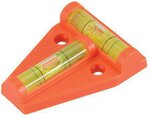As already been identified the nature of the ground, its propensity to allow the load carrying wheels to settle into it , is particularly relevant.
The van's chassis is designed to carry the weight, the steadies as their name implies simply steady it from tipping down.
What the chassis really does not want, is to become a "beam" with the steadies at either end carrying any significant part of the load.
If since setting up, the wheels carrying the load begin to sink, then amounts of the van's weight they had carried, gets progressively transferred to the steadies if they are firmer, developing that beam situation and consequently the chassis sagging in the middle.
If on soft ground, ease and reset the steadies, typically the next morning and again a few days on if on a long period stay.
The chassis and van's structure will benefit from it. If the van is bouncy/springy it is this long beam loading state starting, and the last thing needed is to tighten the steadies to stop it. If the van tips as the occupants move from end to end they are too loose.
Lightly loaded, with decent area load spreading pads, to me makes sense, as does sitting the wheels on two foot long decking planks, on other than hard standings, so the wheels can't sink much.
The logic underpinning using a hammer impact action drill, as so often heard on site, baffles me.




